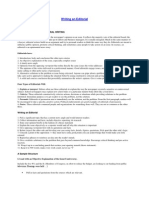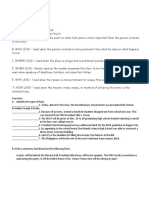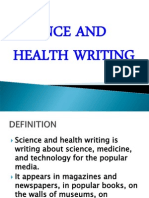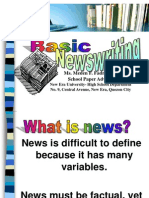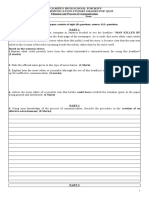Editorialnotes
Editorialnotes
Uploaded by
api-245696323Copyright:
Available Formats
Editorialnotes
Editorialnotes
Uploaded by
api-245696323Original Title
Copyright
Available Formats
Share this document
Did you find this document useful?
Is this content inappropriate?
Copyright:
Available Formats
Editorialnotes
Editorialnotes
Uploaded by
api-245696323Copyright:
Available Formats
IDEOLOGY AND THE NEWS MEDIA
Writing an Editorial
1 of 3
Characteristics of Editorial Writing
An editorial is an article that presents the newspapers opinion on an issue. It reflects the majority vote of the editorial board, the governing body of the newspaper made up of editors and business managers. It is usually unsigned. Much in the same manner of a lawyer, editorial writers build on an argument and try to persuade readers to think the same way they do. Editorials are meant to influence public opinion, promote critical thinking, and sometimes cause people to take action on an issue. In essence, an editorial is an opinionated news story.
Editorials have:
1. 2. 3. 4. an introduction, a body and a conclusion (like other news stories). an objective explanation of the issue. This is especially important with complex issues. a timely news angle. opinions from the opposing viewpoint that directly address the same issues the writer addresses. 5. the opinions of the writer delivered in a professional manner. Good editorials engage issues, not personalities and refrain from name-calling or other petty tactics of persuasion. 6. alternative solutions to the problem or issue being criticized. Anyone can gripe about a problem, but a good editorial should take a pro-active approach to making the situation better by using constructive criticism and giving solutions. 7. a solid and concise conclusion that powerfully summarizes the writers opinion. Give it some punch.
Four Types of Editorials:
1. Explain or Interpret: Editors often use these editorials to explain the way the newspaper covered a sensitive or controversial subject. School newspapers may explain new school rules or a particular student-body effort like a food drive. 2. Criticize: These editorials constructively criticize actions, decisions or situations while providing solutions to the problem identified. The immediate purpose is to get readers to see the problem, not the solution. 3. Persuade: Editorials of persuasion aim to immediately describe the solution, not the problem. From the first paragraph, readers will be encouraged to take a specific, positive action. Political endorsements are good examples of editorials of persuasion. 4. Praise: These editorials commend people and organizations for something done well. They are not as common as the other three types.
IDEOLOGY AND THE NEWS MEDIA
Writing an Editorial
2 of 3
Writing an Editorial
1. 2. 3. 4. 5. 6. Pick a significant topic that has a current news angle and will interest readers. Collect information and facts; include objective reporting; do research. State your opinion briefly in a thesis statement. Objectively explain the issue as a reporter would and tell why this situation is important. Give the opposing viewpoint first supported by quotations and facts. Refute (reject) the other side and develop your case using facts, details, figures and quotations. Pick apart the other sides logic. 7. Concede a point of the opposition they must have some good points you can acknowledge that would make you look rational. 8. Repeat key phrases to reinforce an idea. 9. Give a realistic solution(s) to the problem that goes beyond common knowledge. Encourage critical thinking and pro-active reaction. 10. Wrap it up in a concluding punch that restates your opening remark (thesis statement). 11. Limit your editorial to 500 words; make every word count; never use I.
A Sample Structure
I. Lead with an objective explanation of the issue/controversy Include the five Ws and the H. Pull in facts and quotations from the relevant sources. Additional research may be necessary. II. Present your opposition first As the writer you disagree with these viewpoints. Identify the people (specifically those who oppose you). Use facts and quotations to objectively state their opinions. Give a strong position for the opposition. You gain nothing in refuting a weak position. III. Directly refute the oppositions beliefs You can begin your article with transition. Pull in other facts and quotations from people who support your position. Concede a valid point to the opposition which will make you appear rational, that is, one who has considered all the options. IV. Give other, original reasons/analogies Begin defending your position with strong supporting reasons and build up to your strongest reason. Use a literary or cultural allusion that lends to your credibility and perceived intelligence. For example, We should render unto Caesar that which belongs to him. V. Conclude with some punch Give solutions to the problem or challenge the reader to be informed. A quotation can be effective, especially if it is from a respected source. A rhetorical question can be an effective concluder as well.
IDEOLOGY AND THE NEWS MEDIA
Writing an Editorial
3 of 3
Editorial Structure
Catch attention: Begin with a general statement which does not include the writer's stand on the controversy. Be careful; dont make it too obvious. It should be creative, thoughtful and specific. Concede: After stating thesis, recognize strongest opposing argument.
Commit: The lead should flow naturally into the thesis, or stance, taken by the editorial.
It is true, of course, that but STRONG ARGUMENT
Counter: Switch now into a strong argument in favour of your thesis.
Convince: Build on your last point by making an even stronger point. Be sure points are backed by facts and examples.
Of even greater importance STRONGER ARGUMENT
Finally STRONGEST ARGUMENT
Clinch: Save the strongest argument for last. This discourages rebuttal and leaves the reader with something convincing to ponder.
Commit again: Using different words, restate your thesis.
Cap it off: Leave the reader with a little something extra: a vision of the future, a revisit to the lead, a call to action, etc.
A final note: While professional editorial writers use many different structures, this model serves the beginning writer well. Its principles are solid. After the writer gets more experience, he/she will discover ways to vary the structure depending on the topic and approach. (Source: Alan Weintraut, Annandale High School)
You might also like
- Cae Test One: The Sunday Star Young Writers CompetitionDocument4 pagesCae Test One: The Sunday Star Young Writers CompetitionMaria Luisa Serrano Barba100% (1)
- Sample Editorial WritingDocument2 pagesSample Editorial WritingAlena Mates100% (2)
- 91 Winning Tips in News Writing ContestDocument3 pages91 Winning Tips in News Writing ContestCarl Patrick Tadeo80% (10)
- Copyreading and Headline WritingDocument72 pagesCopyreading and Headline WritingMedem F. Fadriquela100% (5)
- Feature WritingDocument38 pagesFeature WritingMis Dee100% (3)
- Feature Hand OutDocument10 pagesFeature Hand Outerizza0% (1)
- Negotiation RoleplaysDocument3 pagesNegotiation RoleplaysNikocaNo ratings yet
- 298 - Lakme Fashion Week - Associate SponsorDocument47 pages298 - Lakme Fashion Week - Associate SponsorKanishq BawejaNo ratings yet
- Preliminary Numbers - Print Media Job Cuts Between 2008-2013 - CMGDocument13 pagesPreliminary Numbers - Print Media Job Cuts Between 2008-2013 - CMGjsource2007No ratings yet
- EDITORIAL WRITING (Rupert Laxamana) .PPSXDocument69 pagesEDITORIAL WRITING (Rupert Laxamana) .PPSXHazel100% (3)
- Editorial WritingDocument38 pagesEditorial WritingMelanie Antonio - Paino100% (2)
- Writing An EditorialDocument4 pagesWriting An EditorialMaria Lilibeth Initan VisandeNo ratings yet
- Column Writing, Etc.Document16 pagesColumn Writing, Etc.Jayhze DizonNo ratings yet
- Editorial Writing LectureDocument50 pagesEditorial Writing LectureJennifer Lopez100% (1)
- CRHW Fact-SheetsDocument4 pagesCRHW Fact-Sheetss.saligumba.joseferdinandmarcosjayNo ratings yet
- 2018 Editorial WritingDocument47 pages2018 Editorial Writingannabel b. batulan100% (1)
- News Writing Lead WritingDocument1 pageNews Writing Lead WritingGlaiden MaryNo ratings yet
- Column Writing Lecture UpdatedDocument13 pagesColumn Writing Lecture UpdatedEdgar Gorgonio100% (3)
- Sci QDocument33 pagesSci QDonald Bose MandacNo ratings yet
- Writing Science ArticleDocument2 pagesWriting Science ArticleGregorio De Chavez100% (1)
- DSPC Mock Simulation Fact SheetsDocument5 pagesDSPC Mock Simulation Fact SheetsGABRIEL LOUIS GUANONo ratings yet
- Column Writing-An Opportunity To Speak OutDocument2 pagesColumn Writing-An Opportunity To Speak OutKhadeeja Ramzan0% (1)
- Scitech Writing ReadyDocument51 pagesScitech Writing ReadyBryan Jester100% (1)
- Structures of Headlines: Family Planning Seminar HeldDocument7 pagesStructures of Headlines: Family Planning Seminar HeldAvieNo ratings yet
- 2013 Regional Journalism Training HandoutDocument28 pages2013 Regional Journalism Training HandoutStifane Madahan De La Torre100% (2)
- Sci Tech ExercisesDocument9 pagesSci Tech Exercisesgprofessional554100% (1)
- Headline Writing LectureDocument4 pagesHeadline Writing LectureRYAN ROMNICK SANCHEZNo ratings yet
- Feature Writing: by Manuel C. ZacariasDocument4 pagesFeature Writing: by Manuel C. ZacariasKytz Mac100% (2)
- Copy Reading and Headline WritingDocument30 pagesCopy Reading and Headline Writingperpetuabarcia100% (4)
- Feature WritingDocument74 pagesFeature WritingPatricia Damiene Boneo100% (1)
- House Panel Oks Bill Making Baybayin The National Writing SystemDocument1 pageHouse Panel Oks Bill Making Baybayin The National Writing SystemDoc AlexNo ratings yet
- LECTURE News WritingDocument9 pagesLECTURE News WritingRachel Mañosca-Flores0% (1)
- Science Journalism Workshop 1Document28 pagesScience Journalism Workshop 1Mariel EfrenNo ratings yet
- Column Writing: Its Nature and ConceptDocument16 pagesColumn Writing: Its Nature and Conceptmikkaella100% (1)
- Editorial Writing PDFDocument4 pagesEditorial Writing PDFmariam ikram86% (7)
- Collaborative Writing For Desktop PublishingDocument21 pagesCollaborative Writing For Desktop PublishingJudith AbarquezNo ratings yet
- Feature WritingDocument3 pagesFeature WritingB.j. Reyes Ü100% (1)
- Newswriting: Lecture On Campus Journalism By: Sir Pros BonifacioDocument96 pagesNewswriting: Lecture On Campus Journalism By: Sir Pros BonifacioEliza Cortez CastroNo ratings yet
- Feature Writing Module 1Document9 pagesFeature Writing Module 1Maria Contreras100% (2)
- Editorial Writing TipsDocument2 pagesEditorial Writing TipsMhicko SantiagoNo ratings yet
- News WritingDocument67 pagesNews WritingneoclintNo ratings yet
- Headline Writing 2018-2019Document35 pagesHeadline Writing 2018-2019Fe Evangeline Sapon100% (1)
- Fact Sheet For Feature WritingDocument3 pagesFact Sheet For Feature WritingJustine Ignacio100% (1)
- Copyreading RSPC ExercisesDocument7 pagesCopyreading RSPC ExercisesJessa DucoNo ratings yet
- Radio Broadcasting SlidesDocument23 pagesRadio Broadcasting SlidesMarc Raniel Roxford Ugaddan100% (2)
- Science Writing NSPC 2021Document58 pagesScience Writing NSPC 2021Andrea Tepico100% (1)
- Copy Reading and Headline WritingDocument24 pagesCopy Reading and Headline WritingGrace Lancion100% (1)
- Copyreading Regional Clinique PDFDocument58 pagesCopyreading Regional Clinique PDFLeilani Dela Rosa-CalayagNo ratings yet
- Module 3 MAJ06 - Newspaper Layout and DesignDocument15 pagesModule 3 MAJ06 - Newspaper Layout and DesignJohn Francis Ducusin100% (1)
- Science Writing: Lalaine P. JabilloDocument10 pagesScience Writing: Lalaine P. JabilloRossking Garcia100% (2)
- EDITORIAL WRITING LECTURE by Tirso OngDocument104 pagesEDITORIAL WRITING LECTURE by Tirso OngTirso Ong100% (3)
- Basic News WritingDocument71 pagesBasic News WritingJoana Marie CruzNo ratings yet
- Editorial WritingDocument24 pagesEditorial WritingVic V. MagaraNo ratings yet
- The Horizon Volume XIVDocument42 pagesThe Horizon Volume XIVThe HorizonNo ratings yet
- News Writing Med 2Document94 pagesNews Writing Med 2Medem F. Fadriquela100% (3)
- Copyreading and Headline WritingDocument32 pagesCopyreading and Headline WritingChristine T. MompolNo ratings yet
- What Is Sports WritingDocument24 pagesWhat Is Sports WritingklerttoribioNo ratings yet
- Editorial WritingDocument15 pagesEditorial WritingVon Edric JosafatNo ratings yet
- Types of HeadlinesDocument5 pagesTypes of HeadlinesAllondra Dapeng100% (1)
- Sample Column ArticlesDocument4 pagesSample Column Articlesnewteacher deped100% (1)
- Newspaper Layout & Design - Davao PDFDocument21 pagesNewspaper Layout & Design - Davao PDFAna GonzalgoNo ratings yet
- CRHW For Tagaytay MedfadDocument69 pagesCRHW For Tagaytay MedfadMaria Angeline Delos SantosNo ratings yet
- Headline WritingDocument12 pagesHeadline WritingfranzNo ratings yet
- Definition of An Editorial: Persuasive WritingDocument4 pagesDefinition of An Editorial: Persuasive WritingKehm SocayreNo ratings yet
- National Publishing CompanyDocument11 pagesNational Publishing Companysiddhu1579212No ratings yet
- Gcse Business Studies Coursework EdexcelDocument7 pagesGcse Business Studies Coursework Edexcelafiwgxldd100% (2)
- Joe Vitale - Surefire Sales Letter SecretsDocument50 pagesJoe Vitale - Surefire Sales Letter SecretsLévai László100% (3)
- CCS NewspaperDocument8 pagesCCS Newspaperconferjess1212xNo ratings yet
- Tesol 1 2Document5 pagesTesol 1 2esracarNo ratings yet
- What Does Media Do For UsDocument4 pagesWhat Does Media Do For UsfaizanelahiNo ratings yet
- Ict101 Evolution of Media PDFDocument10 pagesIct101 Evolution of Media PDFCatherine Tausa100% (1)
- Newspaper VocabularyDocument6 pagesNewspaper VocabularyClifford FloresNo ratings yet
- WebsiteDocument27 pagesWebsiteSanjay SinghNo ratings yet
- Halal Food Supply Chain Integrity From A PDFDocument23 pagesHalal Food Supply Chain Integrity From A PDFIma AzimaNo ratings yet
- GRADED QUIZ - Elements & Process of CommunicationDocument2 pagesGRADED QUIZ - Elements & Process of CommunicationcandeceNo ratings yet
- Concert Review Analysis Paper Assignment DescriptionDocument2 pagesConcert Review Analysis Paper Assignment DescriptionThomas GluodenisNo ratings yet
- Media and Information Literacy: Quarter 1 - Module 5Document7 pagesMedia and Information Literacy: Quarter 1 - Module 5Queen M SANo ratings yet
- The Village Reporter - August 28th, 2013Document18 pagesThe Village Reporter - August 28th, 2013thevillagereporterNo ratings yet
- Harvard Business ReviewDocument8 pagesHarvard Business ReviewДаша ГуцулякNo ratings yet
- Alas Babylon ProjectDocument1 pageAlas Babylon Projectmooser80No ratings yet
- Capf Study Plan Part 1 PDFDocument6 pagesCapf Study Plan Part 1 PDFAditya DharpallyNo ratings yet
- Propaganda Devices: Learning ObjectivesDocument11 pagesPropaganda Devices: Learning ObjectivesJess ArceoNo ratings yet
- Course Syllabus For NewspaperDocument2 pagesCourse Syllabus For Newspaperapi-29831576No ratings yet
- Super MentorsDocument11 pagesSuper Mentorsjigna1981No ratings yet
- Newspaper ApplicationDocument5 pagesNewspaper Applicationapi-293772840No ratings yet
- News Headlines and FeaturesDocument5 pagesNews Headlines and FeaturesThan PhyoNo ratings yet
- Brief History of The Print Media in IndiaDocument1 pageBrief History of The Print Media in Indiakrunal95150% (2)
- Havard Style of Referencing and CitationDocument17 pagesHavard Style of Referencing and CitationSayaf SalmanNo ratings yet
- SYM 3 U09 ReadingWorksheetDocument6 pagesSYM 3 U09 ReadingWorksheetSamuelPereiraNo ratings yet
- Print Notice LetterDocument2 pagesPrint Notice LetterSharad GautamNo ratings yet











